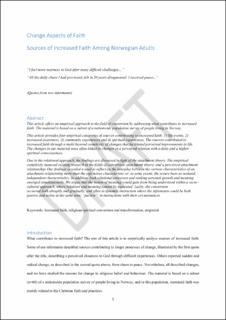| dc.contributor.author | Nygaard, Marianne Rodriguez | |
| dc.contributor.author | Kalfoss, Mary | |
| dc.contributor.author | Kleiven, Tormod | |
| dc.contributor.author | Nilsen, Marianne | |
| dc.date.accessioned | 2022-12-09T07:40:33Z | |
| dc.date.available | 2022-12-09T07:40:33Z | |
| dc.date.created | 2021-11-22T13:11:38Z | |
| dc.date.issued | 2021 | |
| dc.identifier.citation | Pastoral Psychology. 2021, 71 95-117. | en_US |
| dc.identifier.issn | 0031-2789 | |
| dc.identifier.uri | https://hdl.handle.net/11250/3036901 | |
| dc.description.abstract | This article offers an empirical approach to the field of conversion by addressing what contributes to increased faith. The material is based on a subset of a nationwide population survey of people living in Norway. The article identifies four empirical categories of sources contributing to increased faith: (1) life events, (2) increased awareness, (3) community experiences, and (4) spiritual experiences. These sources contributed to increased faith through a multilayered complex of changes that facilitated perceived improvements in life. The changes in participants’ faith were often linked to changes in their perceived relation with a deity and a higher spiritual consciousness. Due to the relational aspect of these sources, we discuss the findings in light of attachment theory. The empirical complexity nuances existing research in the fields of conversion, attachment theory, and perceived attachment relationships. Our findings reveal a need to reflect on the interplay between the various characteristics of an attachment relationship more than the safe haven characteristic or, to some extent, the secure base as isolated, independent characteristics. In addition, relational processes and seeking personal growth and meaning emerged simultaneously. We argue that the notion of meaning would benefit from being understood within a sociocultural approach in which relations and meaning cannot be separated. Lastly, the conversions occurred both abruptly and gradually and often in a dynamic interaction in which the informants could be both passive and active at the same time, or “pactive,” in their interactions with their circumstances. | en_US |
| dc.description.abstract | Changes in Faith: Sources of Increased Faith Among Norwegian Adults | en_US |
| dc.language.iso | eng | en_US |
| dc.publisher | Springer | en_US |
| dc.subject | Kristen tro | en_US |
| dc.subject | Christian faith | en_US |
| dc.title | Changes in Faith: Sources of Increased Faith Among Norwegian Adults | en_US |
| dc.title.alternative | Changes in Faith: Sources of Increased Faith Among Norwegian Adults | en_US |
| dc.type | Peer reviewed | en_US |
| dc.type | Journal article | en_US |
| dc.description.version | acceptedVersion | en_US |
| dc.subject.nsi | VDP::Teologi og religionsvitenskap: 150 | en_US |
| dc.subject.nsi | VDP::Theology and religious studies: 150 | en_US |
| dc.source.pagenumber | 95-117 | en_US |
| dc.source.volume | 71 | en_US |
| dc.source.journal | Pastoral Psychology | en_US |
| dc.identifier.doi | 10.1007/s11089-021-00978-x | |
| dc.identifier.cristin | 1957292 | |
| cristin.ispublished | true | |
| cristin.fulltext | postprint | |
| cristin.qualitycode | 1 | |
